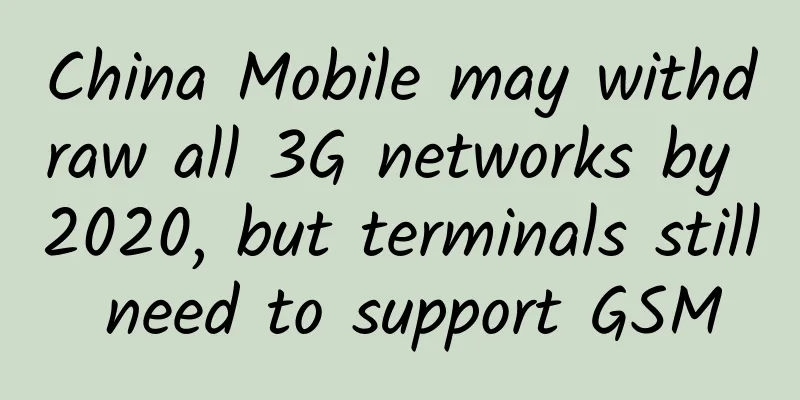China Mobile may withdraw all 3G networks by 2020, but terminals still need to support GSM

|
At the Global Terminal Summit held recently, China Mobile released the "5G Terminal Product Guidelines". This guideline undoubtedly clarifies China Mobile's requirements for 5G terminal products and clarifies the future research and development direction for the industry. It is worth noting that in this guideline, whether it is NSA mode or SA mode, China Mobile no longer requires the terminal to support TD-SCDMA in the mode frequency band. The guidance shows that in terms of mode frequency bands, mobile phones must support at least five modes (NR/TD-LTE/LTEFDD/WCDMA/GSM), and 5G data terminals (such as CPE) must support at least three modes (NR/TD-LTE/LTE FDD), support n78/n79, and recommend n3/n8/n41.
According to China Mobile's 5G network commercialization plan, friendly user testing will be carried out in 2019 and commercial use will be officially launched in 2020. This also means that China Mobile may withdraw all 3G networks before 2020. In fact, the industry has long discussed 2G and 3G, and operators have made plans for the withdrawal of 2G and 3G networks. Especially in the past two years, as 4G network coverage has become increasingly complete and spectrum resources have become tight, some operators have begun to attempt to withdraw 2G and 3G networks. Clearing the frequency and withdrawing from the network has become the general trend of the industry In fact, looking at the global telecom operator market, the withdrawal of 2G and 3G networks is not new. On the one hand, the increasingly complete 4G network coverage can meet the needs of users to communicate and surf the Internet anytime and anywhere. On the other hand, 4G has unparalleled advantages over 2G and 3G, especially in meeting the needs of users for network transmission when using large-bandwidth applications. More importantly, the withdrawal of networks, frequency clearance, and spectrum re-cultivation can allow operators to have more abundant spectrum resources to support the development of new networks. As early as 2008, Japan's KDDI had already withdrawn its 2G network, and operators in South Korea, New Zealand, Thailand, Canada, Australia and other countries have since withdrawn their 2G networks. In recent years, large operators such as Telstra and Verizon, whose networks cover Australia and North America, have also begun withdrawing their 2G networks. Telstra has withdrawn its 2G network in 2016, and Verizon will withdraw its 2G network in 2019. In China, the three major operators have also conducted research and planning for the withdrawal of 2G and 3G networks. On the Communication People's Forum, netizens have repeatedly revealed that the provincial branches of operators are currently reducing the frequency of 2G base stations, withdrawing services, and replacing phones. China Mobile withdraws from the network, we are different However, China Mobile's choice of which network to retire and how to retire is different from other operators. While the world is retiring 2G networks, China Mobile has chosen to retire 3G networks and retain 2G. As early as 2016, the Communication People's Forum broke the news about China Mobile's TDS shutdown plan in a certain province. Last year, the TDS network signal became worse and worse, and the news of TDS withdrawal from the network continued to appear. Correspondingly, while China Mobile is stepping up its 4G construction, it is also continuously expanding and optimizing its GSM network. China Mobile expanded its GSM network in 2016 and 2017, involving BBU+RRU, BSC/OMC-R and other equipment. Industry experts believe that China Mobile's move is very wise. Although the demand for voice has been declining in recent years, voice services are still in high demand. With the 2G network becoming the world's largest 2G premium network and coverage significantly better than 3G and 4G, extending the life of the world's largest 2G premium network to ensure user service experience, especially voice service experience, is undoubtedly the best option at present. The withdrawal of 3G networks and clearing of frequencies can provide more frequency bands for 4G and even 5G, allowing 4G and 5G to provide users with better network coverage experience. At the same time, China Mobile's 2G network will not be withdrawn and can also meet the communication needs of remote areas or special groups, thereby meeting the needs of various user groups. |
>>: Analysis on the development trend of indoor distribution system in the 5G era
Recommend
Did you know? Did you know? Telecom networks should focus on multi-layer orchestration
A few years ago, the word “orchestration” was har...
Tong Yongyue of Yunfan Accelerator: In 2017, we hope to become the standard CDN in the streaming media field
【51CTO.com original article】With the rapid rise o...
The 5G revolution started ten years ago
Will the "Warring States Period" patter...
5G is the best? GSA: Gigabit LTE is advancing rapidly
[[375841]] When it comes to the world's hotte...
[12.12] DogYun Dynamic Cloud 40% off, Classic Cloud 20% off, Dedicated Server 100 yuan off per month, Lucky Wheel Prize draw
DogYun is a Chinese hosting company founded last ...
VMISS 30% off from $2.6/month, Hong Kong/Korea/Los Angeles/Japan IIJ available
VMISS is a foreign hosting service provider estab...
Shandong issues six standards for e-government cloud platform construction
Recently, Shandong issued six standards in the fi...
The Ministry of Industry and Information Technology stated: Promote the development of dual-gigabit networks represented by 5G and optical fiber
China has made some achievements in 5G developmen...
5G and IoT: The mobile broadband future of IoT
5G is the fifth generation of mobile, cellular te...
5G backhaul will become the next growth point in the field of optical communications
According to industry insiders, 5G mobile service...
Summary of precautions and common problems in the use of twisted pair cables in weak current engineering
Twisted pair wire is the most commonly used trans...
Gcore (gcorelabs) Hong Kong VPS simple test
A few days ago, we did a simple test of Gcore'...
18 pictures tell you: 10 key technical points that a 90-point network engineer should master
"As a network engineer, what does it take to...
The Importance of Ethernet Cabling for High-Speed Internet in Your Home
In today's digital age, having a reliable and...
HostYun Los Angeles CU2 (AS9929) VPS simple test
I looked through the previous articles and found ...









